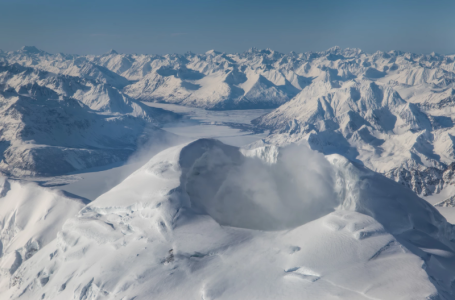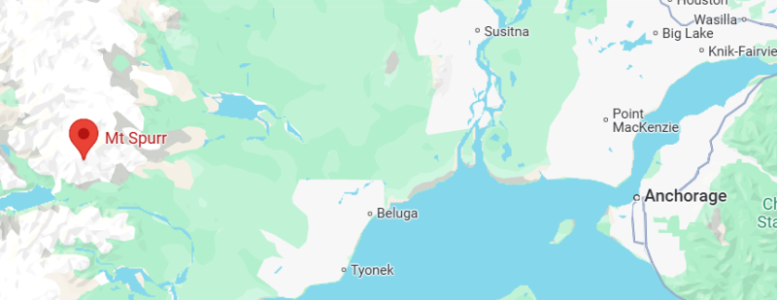Kennywood
Kennywood
- Joined
- Jan 1, 2012
- Messages
- 2,522
For those of you who have an Alaskan cruise booked for next few weeks, you may want to read this:

The likelihood of an Alaska volcano’s explosive eruption not far from the state’s largest city has increased, according to researchers.
Officials with the Alaska Volcano Observatory reported Wednesday morning that flights over the volcano on Friday and Tuesday detected increased gas emissions from Mount Spurr, about 80 miles west of Anchorage and the closest active volcano to Alaska’s population centers. The gas emissions show that new magma has formed under the volcano, which “indicates that an eruption is likely, but not certain, to occur within the next few weeks or months,” the researchers’ update says.
That follows months of unrest, during which the researchers detected an increase in the number of small earthquakes at Mount Spurr, starting in the spring of 2024. That caused the Alaska Volcano Observatory to raise its code for Spurr to yellow, or "advisory" status, in October. In February, researchers said the earthquakes and deformation of the volcano continued, but they said at the time there were equal chances the volcano would erupt or not.
Mount Spurr remained in advisory status Wednesday, but the researchers now predict the most likely outcome of the unrest at the volcano is “one or more explosive events” that could last as long as a few hours and produce ash clouds carried for hundreds of miles.
“More often than not, we have explosive eruptions that fragment magma and shoot ash, you know, 50,000 feet into the atmosphere,” said Matt Haney, who's in charge of the Alaska Volcano Observatory.
Similar eruptions occurred in 1953 and 1992, when roughly a quarter of an inch of ash fell on Southcentral communities. The 1992 eruption resulted in the Anchorage airport closing for 20 hours.
“It started almost a year ago, with increased amounts of earthquakes beneath a volcano, and we've been tracking that closely,” he said.
Then came the increase in gases, the melting of snow and the inflating surface.
“It's almost like we have a checklist of the usual signs that volcanoes give us before they progress to an eruption," he said. "And now we're seeing all four of those are giving us those indicators.”
Haney said the most likely scenario is an eruption not from the summit of Mount Spurr, but at an opening about 2 miles away called Crater Peak.
“The eruptions of Mount Spurr in 1953 and in 1992 were from Crater Peak," Haney said. "And when they flew around Crater Peak, they did not measure sulfur dioxide gas in excessive background there, but they did measure carbon dioxide, which is indicative of magma intruding beneath Mount Spurr in Crater Peak in particular.”
That ash is known to shut down jet engines and cause severe damage to plane exteriors, and Ted Stevens Anchorage International Airport is one of the busiest air cargo hubs in the world. In December 1989, a KLM 747 jet flew through ash from another nearby volcano, Mount Redoubt, and the plane’s engines shut down, forcing an emergency landing in Anchorage with 231 passengers aboard.
On the ground, the most immediate hazard to nearby residents from a Mount Spurr eruption would be from ashfall, which could be carried by winds, State Division of Homeland Security and Emergency Management spokesman Jeremy Zidek said.
“Ash is not good for people to breathe,” Zidek said. “It’s not good for your skin. So what we want people to do during the volcanic eruption is really minimize their exposure to that ash as much as possible. Mask up if they do have to go outside.”
The ash can also impact visibility on the roads and damage vehicles, so residents should limit their driving in the event of an eruption, Zidek said.
“There would be more proximal hazards, like hot flows of ash and gas called pyroclastic flows that would go down the slopes of the volcano," Haney said. "There can also be volcanic mudflows called lahars.”
Though the eruption has the potential to temporarily impact air travel, Zidek said he doesn’t anticipate widespread impacts.
“While we need to be mindful of it and take steps to prevent breathing it, we don't anticipate we're going to see widespread power outages (or) our water supplies being contaminated,” Zidek said. “We don't anticipate that air travel will be canceled for weeks.”
So, while Mount Spurr’s unrest comes with some risks, Haney said there should be ways for residents to see the eruption from a safe distance at Anchorage's Point Woronzof.
“When it comes into Anchorage, it will be almost like a sandstorm with dark ash," Haney said. "It will, if it occurs in daylight, it'll block out the sun.”
If it comes at night, Haney said onlookers can be in for a different visual spectacle
“It can produce a large amount of lightning," Haney said. "We call it volcanic lightning. It's due to charges getting set up by the the ash particles scraping up next to each other.”
Source: https://alaskapublic.org/news/publi...ash-to-states-population-centers-within-weeks
Alaska volcano’s eruption ‘likely,’ could send ash to state’s population centers within weeks

The likelihood of an Alaska volcano’s explosive eruption not far from the state’s largest city has increased, according to researchers.
Officials with the Alaska Volcano Observatory reported Wednesday morning that flights over the volcano on Friday and Tuesday detected increased gas emissions from Mount Spurr, about 80 miles west of Anchorage and the closest active volcano to Alaska’s population centers. The gas emissions show that new magma has formed under the volcano, which “indicates that an eruption is likely, but not certain, to occur within the next few weeks or months,” the researchers’ update says.
That follows months of unrest, during which the researchers detected an increase in the number of small earthquakes at Mount Spurr, starting in the spring of 2024. That caused the Alaska Volcano Observatory to raise its code for Spurr to yellow, or "advisory" status, in October. In February, researchers said the earthquakes and deformation of the volcano continued, but they said at the time there were equal chances the volcano would erupt or not.
Mount Spurr remained in advisory status Wednesday, but the researchers now predict the most likely outcome of the unrest at the volcano is “one or more explosive events” that could last as long as a few hours and produce ash clouds carried for hundreds of miles.
“More often than not, we have explosive eruptions that fragment magma and shoot ash, you know, 50,000 feet into the atmosphere,” said Matt Haney, who's in charge of the Alaska Volcano Observatory.
Similar eruptions occurred in 1953 and 1992, when roughly a quarter of an inch of ash fell on Southcentral communities. The 1992 eruption resulted in the Anchorage airport closing for 20 hours.
A checklist of signs
Scientists like Haney have had their eyes on Mount Spurr for months.“It started almost a year ago, with increased amounts of earthquakes beneath a volcano, and we've been tracking that closely,” he said.
Then came the increase in gases, the melting of snow and the inflating surface.
“It's almost like we have a checklist of the usual signs that volcanoes give us before they progress to an eruption," he said. "And now we're seeing all four of those are giving us those indicators.”
Haney said the most likely scenario is an eruption not from the summit of Mount Spurr, but at an opening about 2 miles away called Crater Peak.
“The eruptions of Mount Spurr in 1953 and in 1992 were from Crater Peak," Haney said. "And when they flew around Crater Peak, they did not measure sulfur dioxide gas in excessive background there, but they did measure carbon dioxide, which is indicative of magma intruding beneath Mount Spurr in Crater Peak in particular.”
Ash could pose hazards
Haney said the explosive eruption that researchers are now predicting could last for as long as a few hours and produce ash clouds carried for hundreds of miles.That ash is known to shut down jet engines and cause severe damage to plane exteriors, and Ted Stevens Anchorage International Airport is one of the busiest air cargo hubs in the world. In December 1989, a KLM 747 jet flew through ash from another nearby volcano, Mount Redoubt, and the plane’s engines shut down, forcing an emergency landing in Anchorage with 231 passengers aboard.
On the ground, the most immediate hazard to nearby residents from a Mount Spurr eruption would be from ashfall, which could be carried by winds, State Division of Homeland Security and Emergency Management spokesman Jeremy Zidek said.
“Ash is not good for people to breathe,” Zidek said. “It’s not good for your skin. So what we want people to do during the volcanic eruption is really minimize their exposure to that ash as much as possible. Mask up if they do have to go outside.”
The ash can also impact visibility on the roads and damage vehicles, so residents should limit their driving in the event of an eruption, Zidek said.
Eruption could occur with 'little or no additional warning'
Haney, the volcano researcher, said an eruption could come with “little or no additional warning” and pose a risk to people closer to the volcano, within about 15 or 20 miles.“There would be more proximal hazards, like hot flows of ash and gas called pyroclastic flows that would go down the slopes of the volcano," Haney said. "There can also be volcanic mudflows called lahars.”
Though the eruption has the potential to temporarily impact air travel, Zidek said he doesn’t anticipate widespread impacts.
“While we need to be mindful of it and take steps to prevent breathing it, we don't anticipate we're going to see widespread power outages (or) our water supplies being contaminated,” Zidek said. “We don't anticipate that air travel will be canceled for weeks.”
So, while Mount Spurr’s unrest comes with some risks, Haney said there should be ways for residents to see the eruption from a safe distance at Anchorage's Point Woronzof.
“When it comes into Anchorage, it will be almost like a sandstorm with dark ash," Haney said. "It will, if it occurs in daylight, it'll block out the sun.”
If it comes at night, Haney said onlookers can be in for a different visual spectacle
“It can produce a large amount of lightning," Haney said. "We call it volcanic lightning. It's due to charges getting set up by the the ash particles scraping up next to each other.”
Source: https://alaskapublic.org/news/publi...ash-to-states-population-centers-within-weeks

